DeFi Uncovered: Hints of a Multichain Future
Interest in alternative smart contract chains hits a new stride in the past weeks, as the prices of Avalanche, Solana and Terra explode higher.
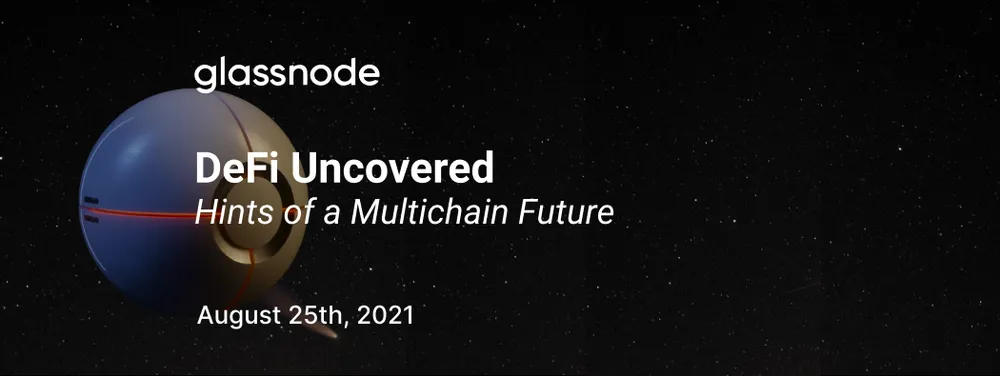
Title image made using art from the NFT-based card game Parallel.
Activity on Ethereum has continued to tick higher, highlighted by the price of gas on the network finding a 3 month high at an average of over 80+ gwei. This marks a strong return of on-chain activity driven largely by usage across DEXs and interest in NFTs. The competition for top gas guzzler has now transferred the crown to OpenSea, which has pushed firmly ahead of Uniswap for the top spot in daily consumption. Users now have NFTs firmly to blame for expensive transaction fees.

Perhaps even more interesting over the last few weeks has been the spike in interest on alternative layer one blockchains. Alternative smart contract platforms like Avalanche and Solana have found massive 30 day token price growth as hints of activity and bets on a multi-chain future start to garner attention.
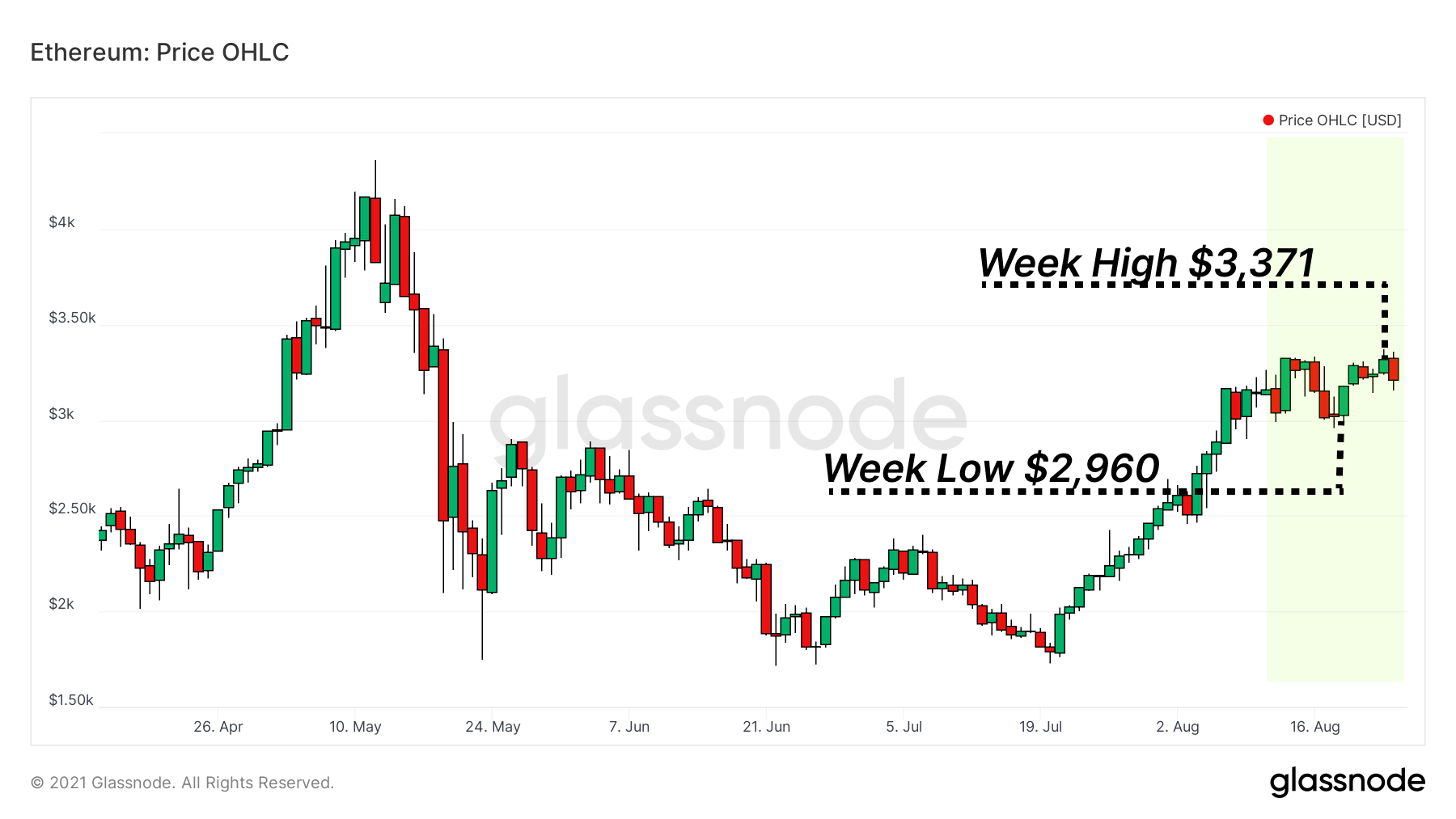
With ETH prices remaining mostly range-bound in the $2,900 to $3,300 consolidation range, a handful of alternative layer ones have all caught strong bids in the past month. Chiefly: Solana (SOL), Avalanche (AVAX), Cosmos (ATOM) and Terra (LUNA) have all experienced significant appreciation relative to ETH, each rallying by over 85%. The rest of space has moved mostly in step with beta (BTC and ETH) and other layer one blockchains like Polkadot and BSC have rallied, although muted in comparison to SOL, AVAX, and LUNA.

Spikes in DeFi activity on each chain have aligned with the native tokens catching a bid. This has especially been the case for Avalanche where $180 million in liquidity mining incentives have triggered a parabolic move in the chain's TVL and in the native token price. The chain's TVL has increased from near zero, to over $1.8B.

Note that with the fifth largest TVL, and the second largest market cap among DeFi focused chains, Solana holds the highest Market Cap:TVL ratio, by a large margin. For every $1 in TVL, the chain has about $8 in market cap. Note that higher MC:TVL ratios suggest a relatively higher speculation premium as the project valuation outruns capital deployed on the chain.
Market Cap:TVL by Chain
- Ethereum: 3.3
- BSC: 4.0
- Terra: 2.0
- Polygon: 2.0
- Solana: 8.3
- Avalanche: 4.6
This means if we assume the total value locked in DeFi is an important metric for valuing a blockchain, Solana may be the most overvalued by this metric.
Let's do a quick overview of Solana (SOL), Avalanche (AVAX), Terra (LUNA), and Cosmos (ATOM), the four chains with native tokens that have rallied the most over the past few weeks. We'll do a quick survey of their progress towards building competitive alternatives to the Ethereum ecosystem for both developers and users.
Avalanche, a meteoric rise, spurred on by $180M in liquidity incentives.
Avalanche is a Proof of Stake chain claiming the most validators and fastest time to finality among active smart contract platforms.
To date, Avalanche has seen fairly low growth, attracting limited liquidity across its DeFi projects until now. The project has since announced $180M in liquidity incentives for DeFi projects are to be awarded via its AVAX token to liquidity providers. The first $27M has been allocated towards Aave and Curve. The incentives, paid in the native token AVAX create a strong incentive for increased usage and user migration to the network. Note the rise in liquidity since the incentives have been announced.
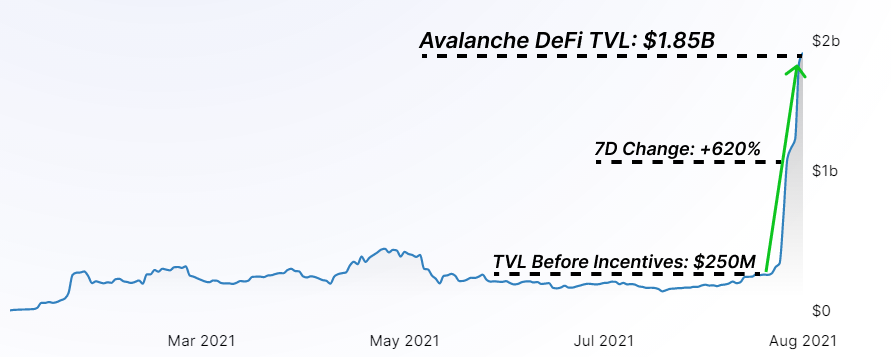
BENQi, a lending market, is the first Avalanche project to reach $1B in liquidity and among the first to add AVAX incentives.
The chain's largest DEX is Pangolin, though the second largest DEX, Trader Joe, is right on its heels. Pangolin has seen enormous growth, benefiting from increased interest in the Avalanche ecosystem. It has watched its daily DEX volume go from $4M average daily volume to over $300M in daily volume, a 75x increase.
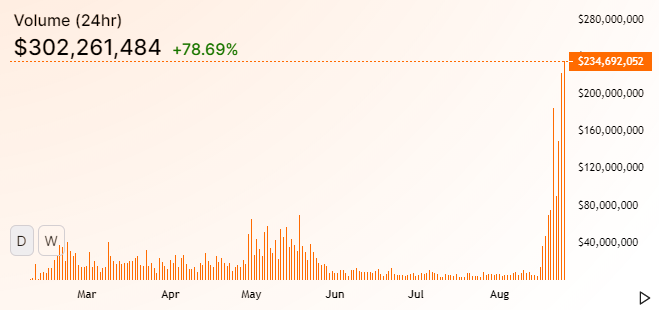
Will the rise of Avalanche persist once Curve and Aave launch alongside attractive incentives? For now, liquidity remains limited, as only 4 protocols on Avalanche exceed $100M TVL, with BENQi dominating. Projects on Avalanche remain marked by being clones of existing projects on Ethereum, attracting this growth through incentives and inflated yields that may or may not persist long term.
Solana, a focus on scaling and ecosystem.
The market leader in our short list of layer one chains, has seen the token price rally from $27 to $70+ over the last 30D period. Solana has driven the growth in its ecosystem through a focus on DeFi protocol implementations through 2020/2021. This growth largely spurred on by support from FTX and Alameda Research, builders of Serum DEX, and significant investors in the Solana ecosystem.
Currently, the hardware required to operate a validator on the network has a CAPEX cost of around $5,000. Solana designers expect that Moore's Law will bring the cost of compute down over the longer term, lowering the barrier to entry, and allowing more validators to come online and secure the network. Their focus on optimization for high-tier hardware has allowed the network to scale, putting throughput regularly above a live 1,000 transactions per second, and capable of much more under load. Smart contracts in Solana are built using the Rust programming language.
The largest DeFi project in the Solana ecosystem is the DEX Raydium. The DEX boasts about $1B in TVL, spread out primarily among Solana ecosystem tokens, though some pools exist for many Ethereum focused projects as well.
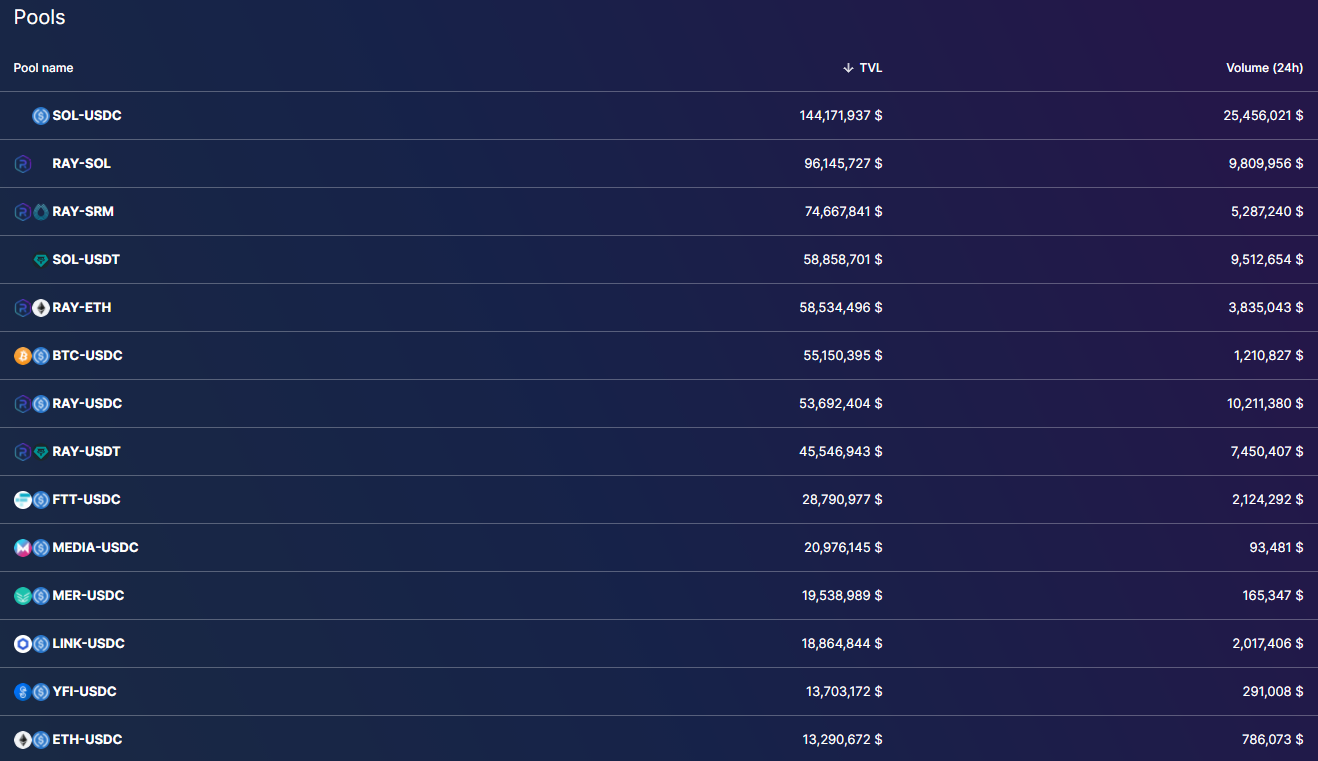
The exchange boasts about $150M in volume on strong volume days, putting it in 7th place for daily volume by DEXs across all chains. Though do note that wash trading and spoofing volume becomes much easier on chains with low fees.
Major liquidity mining farms have strong returns for liquidity providers and stakers at the moment, with rewards payed in DEX token RAY for stakers. Among the largest/lowest risk pool 2s, APRs hover in the 70-100% range. Among the riskier pools APRs regularly exceed 200%+.

To date, the Solana ecosystem has funded many lending protocols, though none have yet managed to attract any significant amount of liquidity. The Solana ecosystem is mostly comprised of analogues to Ethereum projects: Saber at $600M TVL is an analogue to Curve as a stablecoin AMM, and SolFarm is a yield aggregator, an analogue to Yearn and other aggregators, with $260M in TVL at present.
There are five projects in the Solana DeFi space which have more than $100M TVL. For comparison, Ethereum boasts over 60 projects with more than $100M TVL.
Solana certainly presents an attractive alternative option for projects requiring scaling. Though for now it has barely scratched the surface in competing with Ethereum for total liquidity.
Terra, the leading Cosmos IBC/Tendermint blockchain.
Terra is a Tendermint blockchain, built off the Cosmos IBC. Blockchains built using Tendermint have the advantages of interoperability with any other IBC blockchain in the Cosmos IBC. When Agoric, the Tendermint blockchain enabling secure JavaScript smart contracts and other Cosmos IBC projects continue to come online they will be able to easily communicate, by merit of all being built on top of Tendermint consensus.
For now, Terra is the leader in the Cosmos ecosystem. The backbone of Terra is Luna, the token backing the ecosystem's UST stablecoin and securing Terra. Its growth has been spurred on by its two leading protocols - Anchor and Mirror. Dominating activity in lending protocol Anchor is UST, crypto's second largest decentralized collateralized stablecoin.

Anchor Protocol, Terra's largest DeFi protocol, has over $3.4B in TVL, by merit of $1.3B in UST deposits and $2.1B in Luna and ETH. Lenders are currently receiving 19% APY on their UST deposits, and utilization of UST is at 60%. Approximately $769M of the $1.3B UST deposited is currently being borrowed.
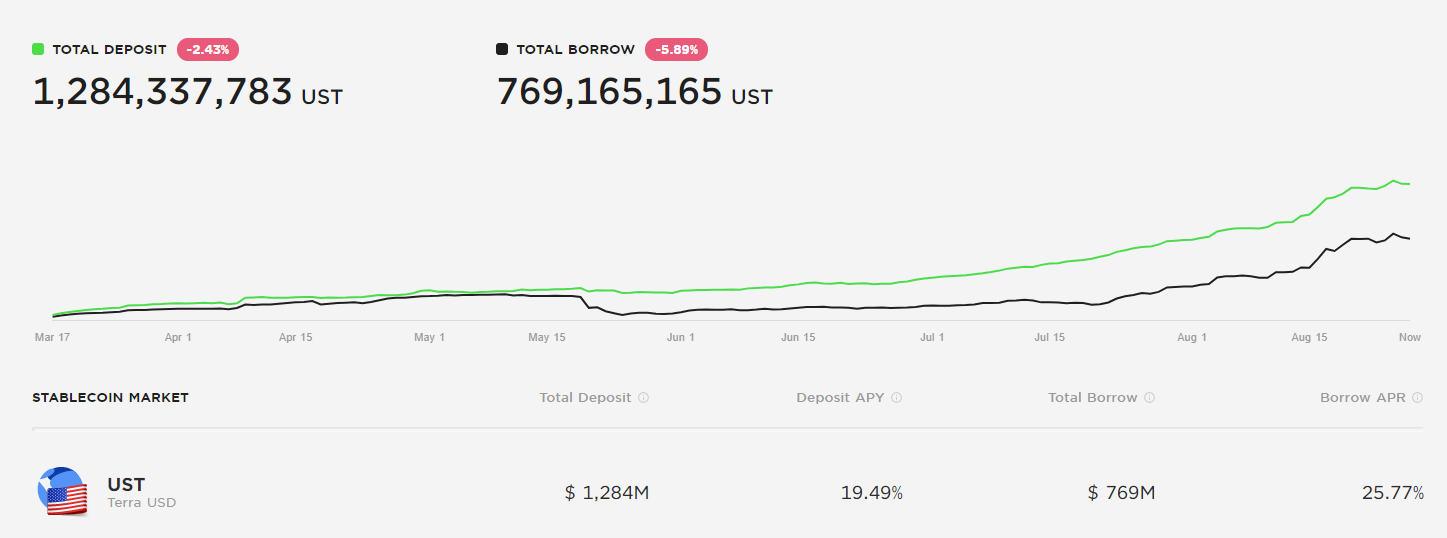
Terra's other protocol showing growth in liquidity is Mirror Protocol. Mirror functions similar to Synthetix, minting synthetic representations of real-world assets like currencies and stocks. The protocol has $1.84B in UST locked and $10M+ daily volume for trading its synthetic assets. This vs Synthetix which typically trades less than $10M daily volume for real-world synthetic assets and $2.2B SNX locked.
Closing Thoughts
While some alternative layer one smart contract platforms have seen their native tokens rally in recent weeks, actual liquidity on each chain remains limited relative to the Ethereum chain. Nevertheless, some chains like Terra have shown non-trivial signs of adoption in a few choice protocols. It is noted that among Solana, Avalanche, and Terra, none of the three currently host more than 5 projects >$100M in liquidity.
It is also noteworthy how liquidity mining incentives attract capital. The growth of Avalanche TVL in particular, centered around the $180m in AVAX rewards, has triggered an inflow of capital. Another observation is that interoperability across blockchains remains limited, meaning every dollar deployed into DeFi protocols on separate chains, does create a fragmentation of activity and liquidity.
As some users traverse across to newer and more experimental blockchains, developers will have to assess the viability and longevity of additional users and capital moving on or off of Ethereum. As competition for users, attention and capital increases, many developers and protocols may find the trade-offs worth it, or even find untapped value and opportunity in protocol design. And if Ethereum L2s struggle to scale the network, or create a heavy barrier for user experience, users may naturally gravitate towards alternative chains in response.

